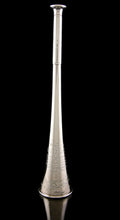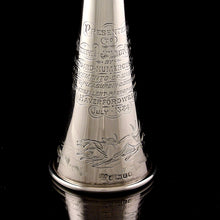Hunting Horn Presented to John Lort Stokes, shipmate of Charles Darwin in H.M.S. Beagle
Adding product to your cart
Length: 30cm\
A silver hunting horn of unconventional length, engraved with quarry and hounds and inscribed, ‘Presented to Admiral J. Lort Stokes / By tenants and numerous friends / as a memento of many years / sport & pleasure in connection with / his excellent pack of hounds / Haverford West / July 1884’. Maker’s mark of by W.W. Harrison & Co. Hallmarked Sheffield 1884.
In April 1882 The Morning Post published Stokes’ tribute to the recently deceased Charles Darwin
‘... perhaps no-one can better testify to his early and most trying labours than myself. We worked together for several years at the same table in the poop cabin of the Beagle ... he with his microscope and myself with the charts. It was often a very lively end of the little craft, and distressingly so to my old friend, who suffered greatly from sea-sickness. After perhaps an hour’s work he would say to me, “Old fellow, I must take the horizontal for it ...” and stretch out on one side of the table. This would enable him to resume his labours for a while when he had again to be down.’
Read more
John Lort Stokes (1811-1885) was the assistant and cabin mate of Charles Darwin in H.M.S. Beagle on the five year trans-world voyage of 1831-36 during which the great naturalist formed ideas that led to his theory of evolution by natural selection. Stokes, who entered the Navy in 1824 and was to serve for eighteen years in H.M.S. Beagle, was the son of a landowner Henry Stokes of Scotchwell House near Haverfordwest, Pembrokeshire. He began his naval career in H.M.S. Prince Regent before joining the 10-gun Cherokee class brig-sloop Beagle in October 1825. He participated in her first voyage accompanying the larger ship H.M.S. Adventure on a hydrographic survey of Patagonia and Tierra del Fuego, during which the captain fell into a deep depression at Port Famine and shot himself. Twenty-three year-old Robert FitzRoy assumed command and Beagle returned to England in 1830.
In 1831 Beagle was recommissioned under FitzRoy’s command to make a second voyage of discovery around South America. Darwin was invited to join and was given the responsibility of contributing a volume on natural history to accompany FitzRoy’s account of the voyage. As Darwin’s Geology of the Voyage of the Beagle recounts, the naturalist spent a great deal of time investigating geology and collecting fossils on land with the help of his cabin mate, John Lort Stokes, who, according to the Australian Dictionary of National Biography, proved an ‘enterprising and efficient officer, ... a man of genial personality, with considerable ability as a vivacious writer.’. The two formed an enduring friendship: - ‘In small ships on prolonged and remote service, personalities can grate and alliances founder, but in the cramped space of the Beagle’s cabin, the chairs of Darwin and Stokes always remained side by side.’
Following the second voyage of the Beagle, Stokes was promoted to the rank of lieutenant, and served under Commander John Clements Wickham for a survey of Australasian waters. When Wickham was invalided in 1841, Stokes took command. Under Stokes the Beagle surveyed Timor and New Zealand, returning to England in 1843. When he returned he wrote his Discoveries in Australia, with an account of the coasts and rivers explored and surveyed during the voyage of the Beagle, 1837–1843; it was published in 1846. In July 1846 Stokes was promoted to captain and commanded the steam ship Acheron surveying New Zealand for four years. From 1860 to 1863 he commanded the ship H.M.S. Rose surveying the coasts of the English Channel. He retired in 1863, was promoted to the rank of rear-admiral in 1863, vice-admiral in 1871 and admiral in 1877. Admiral Stokes died at his home in Scotchwell three years later, being latterly Master of the Scotchwell Harriers. His portrait (BHC3039) by Stephen Pearce is in the National Maritime Museum.
Reference:
Hordern, M. (1989) Marines are Warned! John Lort Stokes and H.M.S. Beagle in Australia 1837-1843, Melbourne University Press, Australia






